Lilac Oysterling
A remarkable looking annual polypore, and a beautiful purple coloured lookalike of the well-known Oyster Mushroom. Because their fruiting time is overlapping, it is worth having a second look before you pick it.
| Mushroom Type | |
| Common Names | Lilac Oysterling (EN), Oragen Lelog (CY), Łyczak Muszlowy (PL), Lilás Dücskőgomba (HU) |
| Scientific Name | Panus conchatus |
| Synonyms | Lentinus conchatus, Pleurotus conchatus |
| Season Start | Aug |
| Season End | Nov |
| Average Mushroom height (CM) | |
| Average Cap width (CM) | 3–10 |
Cap
3–10 cm across, semi-circular to shell-shaped, lilaceous pink at first, with a brownish centre, becoming yellowish brown with age. Flat, with or without a wide shallow umbo at the centre, but also could be slightly depressed or even funnel shaped. Skin dry, smooth or finely hairy (fibrillose), also could be covered with fine scales (squamulose). Margin wavy and inrolled.
Gills
Crowded, forking, decurrent (running down to the stem). White, off-white to cream coloured with entire, concolorous edge.
Stem
2–5 cm long, up to 2 cm wide, eccentrically attached to the cap (they hardly can be separated). It is paler than the cap, a bit less hairy when young, tough.
Habitat
On dead hardwood stumps and large, fallen branches, preferably on birch, beech and ash in the UK (occasionally on poplar in Central to Southern Europe). Saprotrophic, causes white-rot.
Possible Confusion
It can be confused with Panus rudis, which doesn’t seem to have a common English name. It is common and widespread in Central and Southern Europe where it grows on hardwoods (preferably oaks), and its fruiting period normally starts 1-2 months earlier than Lilac Oysterlings’. We aren’t sure if it is really native to the UK or not. There are only a few recordings of it, but they might be faded Lilac Oysterlings.
Osyter Mushroom (Pleurotus ostreatus), pictured, has rather similar look (regardless of its greyish colour), it also grows on hardwoods but it could grow whole year long if the weather is suitable for it. The main difference between Lilac Oysterling and Oyster Mushroom is the colour of the gills (Oyster mushroom has paler, almost pure white gills)
Spore Print
Spore print is pale cream. Spores are colourless (hyalin), ellipsoid and smooth.
Taste / Smell
Considered inedible in Europe (but listed as edible in China). It might have a mild taste, but it is equally possible that we found a bitter specimen, so it is not really worth picking. It has a somewhat sweet, nice smell.
Frequency
Occasional and widespread on the British Isles.
Other Facts
The epithet (the 2nd part of the scientific name) refers to its shape, conchatus means looks like a shell (it became an English word as conchate and/or conchiform).
It is used in Traditional Chinese Medicine (TCM) where it is called ‘Zi Ge Er’ meaning ‘Purple Leather Ear’, however, it is not one of the most commonly used TCM drugs.


 (2 votes, average: 4.00 out of 5)
(2 votes, average: 4.00 out of 5)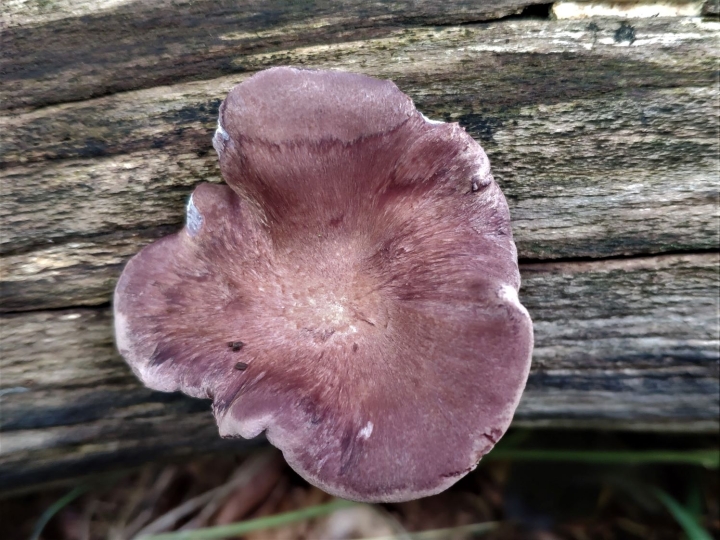















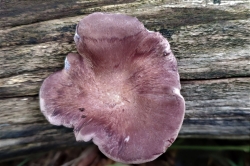
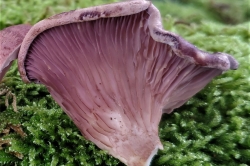
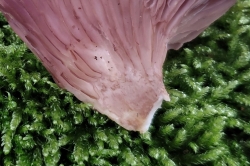
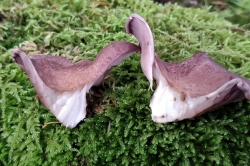
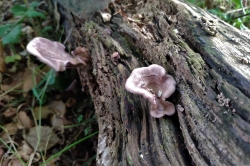
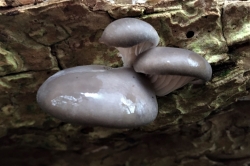






COMMENTS